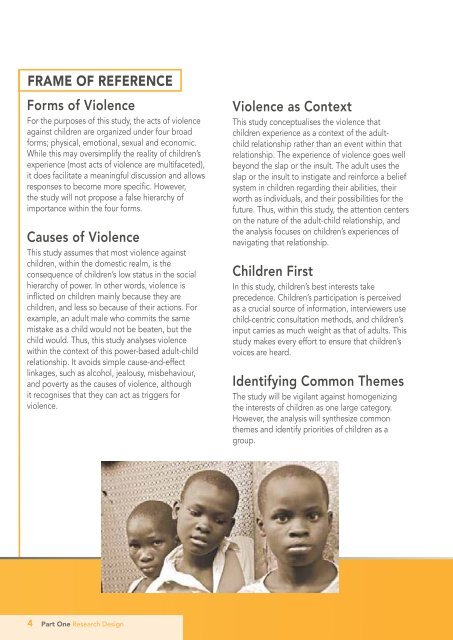Violence against children, the voices of Ugandan ... - Raising Voices
Violence against children, the voices of Ugandan ... - Raising Voices
Violence against children, the voices of Ugandan ... - Raising Voices
Create successful ePaper yourself
Turn your PDF publications into a flip-book with our unique Google optimized e-Paper software.
FRAME OF REFERENCEForms <strong>of</strong> <strong>Violence</strong>For <strong>the</strong> purposes <strong>of</strong> this study, <strong>the</strong> acts <strong>of</strong> violence<strong>against</strong> <strong>children</strong> are organized under four broadforms; physical, emotional, sexual and economic.While this may oversimplify <strong>the</strong> reality <strong>of</strong> <strong>children</strong>’sexperience (most acts <strong>of</strong> violence are multifaceted),it does facilitate a meaningful discussion and allowsresponses to become more specific. However,<strong>the</strong> study will not propose a false hierarchy <strong>of</strong>importance within <strong>the</strong> four forms.Causes <strong>of</strong> <strong>Violence</strong>This study assumes that most violence <strong>against</strong><strong>children</strong>, within <strong>the</strong> domestic realm, is <strong>the</strong>consequence <strong>of</strong> <strong>children</strong>’s low status in <strong>the</strong> socialhierarchy <strong>of</strong> power. In o<strong>the</strong>r words, violence isinflicted on <strong>children</strong> mainly because <strong>the</strong>y are<strong>children</strong>, and less so because <strong>of</strong> <strong>the</strong>ir actions. Forexample, an adult male who commits <strong>the</strong> samemistake as a child would not be beaten, but <strong>the</strong>child would. Thus, this study analyses violencewithin <strong>the</strong> context <strong>of</strong> this power-based adult-childrelationship. It avoids simple cause-and-effectlinkages, such as alcohol, jealousy, misbehaviour,and poverty as <strong>the</strong> causes <strong>of</strong> violence, althoughit recognises that <strong>the</strong>y can act as triggers forviolence.<strong>Violence</strong> as ContextThis study conceptualises <strong>the</strong> violence that<strong>children</strong> experience as a context <strong>of</strong> <strong>the</strong> adultchildrelationship ra<strong>the</strong>r than an event within thatrelationship. The experience <strong>of</strong> violence goes wellbeyond <strong>the</strong> slap or <strong>the</strong> insult. The adult uses <strong>the</strong>slap or <strong>the</strong> insult to instigate and reinforce a beliefsystem in <strong>children</strong> regarding <strong>the</strong>ir abilities, <strong>the</strong>irworth as individuals, and <strong>the</strong>ir possibilities for <strong>the</strong>future. Thus, within this study, <strong>the</strong> attention centerson <strong>the</strong> nature <strong>of</strong> <strong>the</strong> adult-child relationship, and<strong>the</strong> analysis focuses on <strong>children</strong>’s experiences <strong>of</strong>navigating that relationship.Children FirstIn this study, <strong>children</strong>’s best interests takeprecedence. Children’s participation is perceivedas a crucial source <strong>of</strong> information, interviewers usechild-centric consultation methods, and <strong>children</strong>’sinput carries as much weight as that <strong>of</strong> adults. Thisstudy makes every effort to ensure that <strong>children</strong>’s<strong>voices</strong> are heard.Identifying Common ThemesThe study will be vigilant <strong>against</strong> homogenizing<strong>the</strong> interests <strong>of</strong> <strong>children</strong> as one large category.However, <strong>the</strong> analysis will syn<strong>the</strong>size common<strong>the</strong>mes and identify priorities <strong>of</strong> <strong>children</strong> as agroup.4Part One Research Design
















